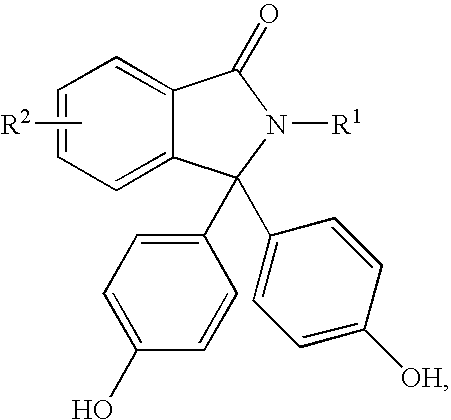Methods for producing and purifying 2-hydrocarbyl-3,3-bis(4-hydroxyaryl)phthalimidine monomers and polycarbonates derived therefrom
- Summary
- Abstract
- Description
- Claims
- Application Information
AI Technical Summary
Benefits of technology
Problems solved by technology
Method used
Image
Examples
example 1
[0091] This Example describes the preparation of para,para-PPPBP containing less than or equal to about 1,000 parts per million of ortho, para-PPPBP isomer impurity.
[0092] Phenolphthalein (31. 8 grams), aniline (65 milliliters), and concentrated hydrochloric acid (20.5 milliliters) were taken in a reaction flask fitted with a Dean Stark condenser. The reaction mass was heated to an internal temperature of 155° C.-165° C. Water was collected during the course of the reaction. After being heated at this temperature for 14-15 hours, the reaction mixture was poured into a mixture of hydrochloric acid and water. The crude product, which precipitated, was collected by filtration and dissolved in an aqueous sodium hydroxide solution containing activated charcoal. After being stirred for about 30 minutes, the mixture was then filtered to remove the charcoal. The charcoal treatment step was repeated once more, and the resulting filtrate was treated with concentrated hydrochloric acid to pre...
example 2
[0093] This Example describes the general melt transesterification method used for preparing polycarbonate copolymers using 47 weight percent of diphenyl carbonate and 53 weight percent of a monomer mixture consisting of 75 weight percent of BPA and 25 weight percent of the purified para,para-PPPBP prepared in accordance with Example 1.
[0094] A glass polymerization reactor was passivated by soaking the reactor in a bath containing 1 molar aqueous hydrochloric acid solution. After 24 hours, the reactor was thoroughly rinsed with demineralized water, and finally, with deionized water to ensure that all traces of acid and other contaminants were removed. The reactor was then thoroughly dried and charged with the appropriate amounts of the purified para,para-PPPBP monomer or a monomer mixture comprising the purified para,para-PPPBP and diphenyl carbonate monomers. The reactor was then mounted in a polymerization assembly and checked to ensure that no leaks were present. The catalyst so...
example 4
[0098] This Example describes the general procedure for the interfacial polymerization method using a monomer mixture comprising a 75:25 mole ratio of purified para,para-PPPB.P (prepared in accordance with method described in Example 1) and BPA, respectively. The procedure used here is as described in U.S. Pat. No. 5,804,525, where the monomer mixture (as described above) and para-cumylphenol was reacted with phosgene in methylene chloride in the presence of tetrabutylammonium bromide. During addition of phosgene, the pH of the reaction mixture was maintained at about 10.5 by slow addition of aqueous sodium hydroxide. After phosgene addition, triethylamine was added to react out trace levels of chloroformate derivatives present in the reaction mixture. The polycarbonate thus prepared had the following physical properties: YI (yellowness index, ASTM D1925): 9; Notched izod at ambient temperature (ASTM D256): 4.9 foot-pound per inch; Glass transition temperature: 191° C.; Delta YI (AS...
PUM
| Property | Measurement | Unit |
|---|---|---|
| Temperature | aaaaa | aaaaa |
| Temperature | aaaaa | aaaaa |
| Temperature | aaaaa | aaaaa |
Abstract
Description
Claims
Application Information
 Login to View More
Login to View More - R&D
- Intellectual Property
- Life Sciences
- Materials
- Tech Scout
- Unparalleled Data Quality
- Higher Quality Content
- 60% Fewer Hallucinations
Browse by: Latest US Patents, China's latest patents, Technical Efficacy Thesaurus, Application Domain, Technology Topic, Popular Technical Reports.
© 2025 PatSnap. All rights reserved.Legal|Privacy policy|Modern Slavery Act Transparency Statement|Sitemap|About US| Contact US: help@patsnap.com



